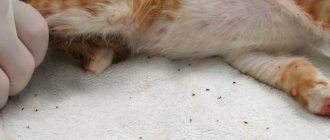11410Administration
While observing his pet, the owner may notice some oddities in his behavior. For example, he notices that the cat is shaking its head and at the same time scratching its ears with its paws. A suspicious person may suspect something wrong in any trifle, however, some vigilance never hurts, especially when it comes to cat ears. A cat has naturally very acute hearing, so its ears are very important to it. Problems with the hearing organs can bring her a lot of trouble.
If a cat shakes its head and scratches its ears, could this be an alarming symptom, or should it not be paid any attention to?
Pathological signs
Minor rare scratching (2-3 times a day) and head shaking cannot be called odd: all living organisms scratch and shake their heads, cats are no exception. But if the cat begins to itch constantly and at the same time tears his ears with his paws with all his might, you should pay special attention to this. These symptoms are often accompanied by other alarming signs that should alert the pet owner. These are the signs:
- The animal behaves restlessly, gets irritated and nervous for no reason.
- The cat actively shakes its head, tilts it down or to the side.
- When scratching its ears, the pet emits a hiss or an angry purr, and meows pitifully and loudly.
- Scratching left bloody marks inside and around the ears.
- The cat is trying to rub its muzzle and ears on everything around it.
- It is possible that the cat's body temperature may increase.
- The animal does not allow its ears and head to be touched, reacting painfully to any touch.
- The inner surface of the ear becomes red or swollen.
- Various discharges flow from the ear.
- Brown crusts and ulcers appeared in the ear.
Have you noticed this behavior in your cat? So it's time to see the vet.
© shutterstock
Reasons for strange behavior
If a cat's ears itch and it shakes its head, then the reason may be hidden in the most ordinary phenomena. This, for example, could be earwax that has accumulated in large quantities or water that has penetrated into the auricle during water hygiene procedures. Or perhaps a foreign object has gotten into your pet’s ear, or there are fleas.
There are other factors that may explain why a cat shakes its head. These symptoms are caused by specific cat diseases, as well as pathologies common to both humans and cats. Here are the main ones of these ailments:
- inflammation of the ear canal (otitis media);
- presence of tumors;
- hematoma or other head injury;
- fungal infection of the skin of the ears;
- dermatitis;
- allergic reaction;
- ear mites or other parasites that cause scabies.
All these conditions require specialist consultation and immediate treatment.
First, it’s worth taking a closer look at some of the most common diseases of furry pets.
What does head shaking in cats mean?
If a cat shakes its head frequently or too intensely, there is a reason for this; it may be due to illness or exposure to the external environment. This behavior cannot be left to chance, since many diseases can have irreversible consequences.
The most common reasons why a cat shakes its head is pain or itching. When a pet suffers from itching, the problem is most often localized in the ear area. When a cat scratches its ears with its hind paws, it releases its claws and severely injures the skin. Scratches become swollen and infected, leading to pain.
The conclusion suggests itself - itching is only a symptom, and the true cause of head shaking is always pain.
There is also an option that is not associated with illnesses - this is a foreign body stuck in the ear canal or blocking it . If you suspect that there is something in your cat's ear, it is strongly recommended that you do not try to treat it at home. By contacting a professional, you can be sure that immobilizing measures will be applied to the animal if the condition threatens to worsen.
If you try to get the object yourself, the pet may jerk and the foreign body will push even deeper. Keep in mind that cats have an L-shaped ear canal, which is also thin and sensitive.
Are you sure there's nothing stuck in your pet's ear? In this case, the cause may be an accumulation of sulfur or disease . As mentioned above, cats have an L-shaped ear canal, which can make wax plugs invisible. If you haven't cleaned your cats' ears as a preventive measure, it is recommended that you contact your veterinarian. The doctor will clean your pet's ear canals with a special solution that softens the wax and allows it to leave the ear naturally. Of course, you can do all these procedures yourself, but if the cause of discomfort is not wax plugs, getting liquid into the ear canals is highly undesirable.
Many owners, noticing that their pet has ear pain, begin treatment with broad-spectrum drops on their own. Quite often this method works, although it is not entirely correct. For adequate therapy that will not harm the pet’s health, it is necessary to identify the exact cause of the discomfort. The use of medications based on intuitive sensations is also a method of treatment, but it is relevant if the doctor cannot find the cause and acts by exclusion.
When a cat shakes its head, the cause is most likely in the ears, but there are other options. If the problem is not identified at the first visit to the veterinarian, the diagnostic process will be delayed. The pet will be prescribed symptomatic treatment, and the owner will need to pay maximum attention to the cat’s behavior and changes in it.
Ear mites
A cat constantly scratches its ear and shakes its head if it has parasites. Infection with ear mites occurs from other cats; contact with street animals is especially dangerous.
This mite is not dangerous to humans; it lives and reproduces only in animals, causing ear scabies or otodecosis in them. Adult dogs and cats rarely suffer from scabies, but ear mites are found much more often in puppies and kittens.
The parasite is localized in the ear area or around it. In the animal's ears, you can notice a sticky brown liquid that dries and crusts over the skin of the ear. To diagnose the disease, a scraping is made from the skin in the ear area. The owner himself can notice the tick using a magnifying glass.
© shutterstock
Parasites and tremors
If a cat jerks its head strangely, the owner should first examine the ears. Involuntary head tremors are one of the main symptoms of otodectosis. The disease is also called ear scabies. It is caused by the activity of microscopic mites that infect the ears of animals that spend a lot of time outdoors.
Ear scabies are more often detected in small kittens and weakened older animals that often go outside. It is the decrease in one’s own immunity that is one of the factors predisposing to the development of such a disease.
An animal can only get the disease through contact with a street relative. Otodectosis is characterized by seasonality - the mite is most active in spring and the first half of summer. Specific symptoms of the disease:
- itching in the ears, which causes the cat to shake its head;
- thinning hair on the ears;
- restlessness, anxiety;
- the formation of crusts on the tips of the ears and in the shells;
- dark discharge instead of sulfur.
Long-term progression of the disease leads to hearing impairment. This is due to the formation of dense plugs that block the ear canal.
The cat, feeling discomfort, tries to get rid of microscopic parasites. The animal begins to scratch its ears, which is dangerous due to infection. Often, with a long course of otodectosis, there is an increase in body temperature, swelling of the ear and redness of the auricles. There may be discharge of pus and dark masses from the ears.
Treatment of the disease can be done at home. To do this, you need to purchase ear cleaning products and products with an antibacterial component. Amitrazine drops are most often prescribed.
You might be interested in: What causes red spots on a cat's tongue?
The cat's ears must be cleaned with a cotton swab. With otodectosis, the wax becomes dense and difficult to clean off, so you can use a special product from a veterinary pharmacy, which is designed to soften the wax and facilitate the process of cleaning the ears.
After cleansing, the ear should be thoroughly wiped with a cotton pad and Amitrazine should be used. The drug is used three times a day, one drop. Repeated treatment is carried out after three days. If necessary, the drug can be used up to three times, maintaining the interval specified in the instructions between ear treatments. In order for the body to recover faster, it is necessary to introduce vitamin supplements into the diet to strengthen the immune system. As a rule, head tremors due to otodectosis disappear on the third day after the start of treatment.
Sarcopid mites
If your cat's ears are shaking, this could be a sign that she has another type of mite. Such mites can spread not only in the ear area, but also in other parts of the cat’s body. They cause another feline disease, notoedrosis.
The head is affected first, then the entire body. The skin at the site of infection becomes dry and dense, covered with a crust, and the crust subsequently cracks.
To make an accurate diagnosis, you need to show the cat to a specialist. He will take a sample from the surface of the skin for analysis. Only the outermost layer from the inflamed area is scraped off; ticks can be seen there.
Both types of ticks provoke severe itching in the animal, forcing them to scratch the skin until it bleeds. Scabies that affects the ears can lead a cat to deafness or meningitis; in especially severe cases, the death of the pet can occur.
Otitis and its varieties
Otitis is an inflammatory process affecting the external, middle or internal auditory canal. There may be several reasons for the development of such a pathology:
- excess wax in the ears;
- colds caused by prolonged exposure to the cold;
- foreign bodies entering the ear;
- infections;
- allergy;
- diseases of internal organs (liver, pancreas);
- fungus;
- complication of notoedorza or otodecosis.
To prescribe the correct treatment, it is necessary to diagnose the cause of the disease in a specialized laboratory. The veterinarian must take a swab from the cat's ear for analysis.
In addition to ordinary otitis, in cats there is otitis of a bacterial nature, when a secondary bacterial infection is added to the inflammation of the ear.
In this case, the so-called bacterial or secondary otitis develops. It can be recognized by the abundant discharge of pus.
© shutterstock
Otitis of mixed etiology also occurs in animals. This happens when the ear is affected by several types of otitis media at once. In this case, the disease occurs in a particularly severe form and causes serious complications.
How to help your pet
Options for providing assistance to the injured animal are selected after establishing the exact cause of the pathological condition.
Removing wax plugs at home
The cat begins to shake its head if it is bothered by wax plugs. You can clean your pet's ears yourself. Saline solution or hydrogen peroxide will help in this situation. The selected product is instilled into the ear canal, 2-3 drops three times a day. The treatment course lasts 7 days . Subsequently, the animal usually successfully copes with this problem on its own.
If the cat is unable to remove the plug, the owner himself can remove it using a cotton-tipped swab or a piece of gauze. As a last resort, it is recommended to contact a veterinary clinic.
Surgical intervention
This type of treatment will have to be used if a tumor or foreign object is discovered in the cat that cannot be removed in any other way.
Surgery may also be recommended in cases of chronic otitis media, which results in narrowing of the ear canal.
Feline dermatitis
Has your cat started shaking his head all the time? Perhaps he has dermatitis. The disease is treated as follows:
- Remove the crust with a piece of cotton wool or gauze using hydrogen peroxide.
- Lubricate weeping ulcers with preparations with astringent properties (“Silver nitrate” 2%).
- Place drops containing novocaine into the ear canal. This will help relieve attacks of itching.
Continue treatment until symptoms disappear completely.
Fungal infections
If the fungus has entered the cat's ears, he begins to actively shake his head. In this situation you need to act like this:
- Every day, clean the ears with Chlorhexidine (0.05% solution).
- Give the animal the antifungal drug “Ketoconazole” for internal use, dose – 5 mg per 1 kg of cat’s weight. Take twice daily.
- Otibiovin drops will have an effective effect. They need to be instilled several times a day into the pet’s ear.
© shutterstock
Fleas
If there are fleas, you need to start treatment immediately. The following steps will help get rid of parasites:
- The ear needs to be treated with a special preparation against parasites.
- After some time, clean the auricle from dead insects with a piece of cotton wool soaked in hydrogen peroxide.
- The entire cat should be thoroughly washed with flea detergent.
If necessary, the procedure must be repeated.
Ear scabies mites
This attack is treated with special antiparasitic and anti-inflammatory drugs:
- in the form of ear drops, ointment preparations (“Tactic” or “Amit”);
- in the form of injections (“Otodecnin”);
- Hydrogen peroxide and a soft tampon are used to remove purulent plaque in the ear.
Both ears must be treated at once, even if symptoms are found in only one.
How is notoedrosis treated?
Parasites must be combated with ointments and special detergents: tar, sulfur sediment, green soap.
In case of a particularly severe form of infection, use “Hyposulfite” and “Benzyl benzoate” to treat the affected areas.
If purulent formations appear, antibiotic treatment must be added.
© shutterstock
Otitis
Inflammation of the ear canal can be cured using a whole range of measures:
- if there is purulent discharge, it is removed with hydrogen peroxide and a piece of cotton wool;
- drops are instilled against otitis (Aurikan, Surolan, Oridermil, Oritsin, Bars);
- Novocaine is used to relieve pain (it is injected at the base of the animal’s ear);
- For allergic otitis, antihistamines are used.
For otitis media of a bacterial nature, the cat is treated with Otonazole, Mastiet, and Otibiovin. These are preparations for topical use.
Allergy in a cat
Animals, like people, also have allergies. Often such a reaction occurs to certain types of food or household chemicals. An allergy can be suspected if the cat shakes its ears, and at the same time its ears are clean . Treating such an ailment is simple: they use the same means that treat allergies in people (antihistamines for oral and local use).
Why does a cat scratch its ears?
It is normal for pets to scratch their ears. So they independently clean them of foreign particles and dirt. An animal can perform this necessary hygienic procedure several times a day; there is nothing unnatural about this. But there are some signs that should alert the owner:
- The cat scratches its ears continuously and at the same time strongly shakes its head in one direction or the other, as if trying to free itself from some object.
- The cat becomes restless, irritable, and sometimes aggressive.
- When scratching its ears, the animal can make various sounds, hiss, purr, and meow.
- Scratches, wounds, and sores appear behind the ears and in the shells, causing painful discomfort to the cat.
Why do my cat's ears itch? The causes of this phenomenon are usually divided into two groups - everyday and pathological.
Household infections can be diagnosed by owners, go away on their own after some time and do not require drug treatment. These include:
- Getting water into your ears after swimming.
- Foreign body.
- Minor hematoma resulting from trauma.
- A large amount of sulfur accumulated in shells due to insufficient care, which the cat is not able to remove without outside help.
It may well be that the cat simply rested his ear and is scratching it because of this, so before you run to the veterinary clinic, you should observe the pet’s behavior.
Pathological causes pose a serious danger to the health of the cat, these include:
- otitis;
- fleas;
- allergy;
- neoplasms in the ears, including malignant ones;
- fungal infections;
- dermatitis, eczema;
- ear mites (otodectosis);
- abscess.
These diseases require immediate treatment; the veterinarian will tell you what to do in such cases.
Ear scabies
Otodectosis (ear scabies) is the most common contagious disease of pets. It is caused by skin-eating mites, the size of which does not exceed 0.7 mm, so it is not possible to detect them without a magnifying glass. Blood-sucking parasites settle in the auricle inside and outside and affect the ear canal and eardrum. Ticks begin to suck the kitten's blood, thereby causing itching, discomfort and irritation.
INTERESTING TO KNOW: Problems with eye suppuration in cats
The cat scratches its ears until it bleeds, shakes its head uncontrollably and meows pitifully. Subsequently, the ears become covered with scabs, and pus is released from the shells. If treatment is not started in time, otodectosis leads to complications in the form of otitis media, meningitis, and death is possible.
To disinfect and eliminate itching, you can instill a 2% solution of hydrogen peroxide into your ears or smear them with regular vegetable oil. After instillation, the ears should be wiped with a cotton swab.
To treat the ears, anti-scabies drops Bars are used, which are instilled into both ears. Amit, Tactic, Otodeknin can also be used. If otodectosis has caused otitis, then tetracycline antibiotics are indicated.
Notoedrosis
Why does a cat scratch his ears and ears? The reason for this may be notoedrosis, a disease caused by the sarcopid mite (Notoedres cati), which affects not only the ears, but also the nose and areas above the eyes. The disease is dangerous because it causes disorders of the nervous, cardiovascular, and reticuloendothelial systems of the body.
First, the tick infects the muzzle and head, then the rest of the body. The cat scratches one or both ears and experiences severe itching. The skin becomes dry, rough, crusts appear on it, crack and bleed.
If the disease is at an initial stage, then tar, green soap, and sedimentary sulfur are used to eliminate the pathogen. Crusts are removed with warm soapy water. At the severe stage, more powerful agents are used - benzyl benzoate suspension and hyposulfite solution. If a cat has ulcers, antibiotics, painkillers and restorative drugs are indicated.
Otitis
With inflammation of the middle ear, the cat constantly scratches its ears until it bleeds, begins to tear the skin, shakes its head, and serous fluid and pus are released from the shells. There are three types of otitis media:
- tick-borne
- bacterial,
- mixed.
Tick-borne otitis media is nothing more than a complication of otodectosis. The treatment is complex, using the drugs Decor, Tsipam, Anandin.
Bacterial otitis media appears when secondary microflora develops in the ears. It is caused by yeast fungi or Malassezia, which occurs due to allergies and weakened immunity. Shampoos Nizoral, Sebazol, as well as drugs Clotrimazole, Aurizol, Otibiovin, Otonazole, Mistiet are used for treatment. In advanced cases, novocaine blockades with an antibiotic are placed (in the presence of severe pain). If allergies are present, antihistamines are indicated.
For mixed otitis, Oridermil, Oritsin, Aurikan, and Bars drops are prescribed. It is important that the medications do not contain hormonal substances.
INTERESTING TO KNOW: Tail injury in a cat: what to do?
Pus is removed from the ears using hydrogen peroxide. Regardless of the etiology of otitis, it is very important to take care of increasing the pet’s immunity.
Fleas
Even if a cat does not go outside, he is not immune from such a scourge as fleas. The symptoms are the same as for the diseases described above: the cat scratches its ears and shells until it bleeds.
As a rule, the veterinarian prescribes the use of antiparasitic drugs (they can also be used as prophylaxis) Stronghold, Bars, Frontline, which are dripped onto the withers. You can use a shampoo of the appropriate spectrum.
Dead parasites are removed from the fur using a cotton swab soaked in hydrogen peroxide or a comb.
During treatment, the animal is isolated, contact with other pets is excluded. The rehabilitation period must be completed completely.
Hematoma
As a rule, small swellings that cause the cat to scratch and scratch their ears until they bleed will resolve on their own within 2 weeks. As first aid, you can use cold compresses and tight bandages. More complex cases require qualified veterinary care. They puncture the hematoma and suck out the blood contents.
Next, a solution of novocaine with hydrocortisone, an antibiotic, is administered. Intramuscular injections of Vikasol are indicated. After the hematoma has resolved, UHF procedures are prescribed.











